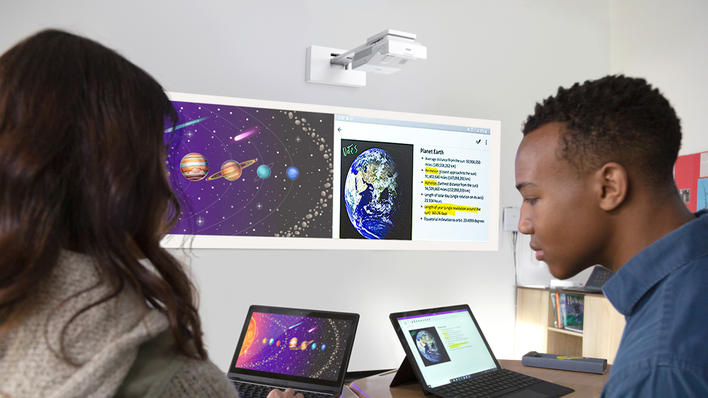It’s a busy morning on the roads but luckily your phone has already alerted you that you need to set off early so you don’t miss your 10 a.m. lecture. While you’re on the bus, your university app informs you that your afternoon tutorial has been moved to Tuesday and is now in a different room. No need to worry: The integrated map will show you the way there. The text you need has been automatically downloaded for you. And the app has also noticed that there are only two of your favorite ham-and-cheese toasties left in the main canteen — but don’t worry, the students’ union cafe has plenty.
Welcome to the campus of the future. In fact, we might not even need to wait as long as 10 years for this kind of interaction. All the technology required to make it a reality already exists at a consumer level — from connected devices and voice assistants to monitoring sensors. Bring it all together and you’ve got an “intelligent campus,” where data is seamlessly integrated.
Currently, university-based learning involves a combination of the physical and digital — class handouts combined with communal online platforms. But universities should be more ambitious, argues Peter Karney, head of production at Digital Catapult, a UK-based agency that supports the early adoption of advanced digital technologies. He says that learning environments, specifically universities, “are at the heart of innovation in the UK and, for many of us, it’s where the spark of imagination is.”
However, upgrading a university with new technology isn’t easy. There’s a vast amount of infrastructure to consider: library systems, student recordkeeping, even central heating. Plus, it costs money — building a voice assistant from the ground up will set any institution back a tidy sum. As for replacing the old tech with connected tech, the benefits would have to significantly outweigh the financial and time cost of installing and implementing it.
But it’s highly likely the benefits will win out in the coming years, according to a report from Jisc, a membership organization that provides digital solutions for UK education and research. That’s thanks to the internet of things (IoT) — tech talking to tech via the internet, such as Amazon’s smart assistant Alexa.
“Picture a room that knows not just how many people are in it, but also where they’re sitting, and how they’re feeling — or even what they’re thinking,” says Martin Hamilton, a futurist at Jisc. “Now imagine that this data is part of a ‘campus brain,’ an artificial intelligence that is constantly matching and classifying its data inputs and either taking action autonomously or alerting its human minders when it thinks action needs to be taken.
“This might sound far-fetched, but in many ways we do these sorts of things already — often quite slowly and labor-intensively. For instance, student feedback forms might indicate that there is a problem with a particular lecture theater — perhaps the lighting isn’t good enough, or there is a lot of noise from a lab next door.”
Universities could use this data to create a much better experience for students, according to Jisc’s deputy chief innovation officer, Andy McGregor. “If a lecture has moved or is canceled, students could get that information sent straight to their phones automatically, saving time and frustration,” he points out. The benefits also extend beyond learning. Granular pieces of information such as “Are there any kosher options left in the canteen?” can all be monitored using IoT too. It could also help to create “sticky campuses” — digitally enabled learning spaces where students want to spend time, even if they’re not attending lectures.
Another technology universities are experimenting with is chatbots. These are conversational programs that can respond to verbal prompts, ideal for answering basic, pre-programmed questions. The tech uses speech recognition and has been applied to language learning services, including popular apps such as Duolingo bots, which have been trialed by universities in the UK. This means languages can be practiced in real-time, with almost all the spontaneity of an organic conversation.
McGregor says that, to date, Leeds Beckett University has created a chatbot to help with clearing enquiries and Bolton College has created a chatbot called Ada that delivers personalized learning to students and answers their queries. “These cut down time spent on admin, allowing more time to be spent on teaching.
“I think chatbots also have an interesting coaching function that will allow students to practice and refine their learning in between sessions with the human teacher,” he adds.
Research is also being carried out into something called nudging. Less a new tech, more a psychological concept, nudging involves a gentle suggestion that could be used to enforce positive behaviors. Struggling students, for example, could be sent a suggestion to take out a book from the library that helped students facing similar challenges in previous years.
As for augmented reality (AR) and virtual reality (VR) — an AR teacher overlaid atop your field of vision, thanks to some smart eyewear, could bring the sense of one-on-one learning to a home-schooled student. Medical students could perform mock VR surgeries, with the operation visually displayed through a headset.
McGregor agrees that AR and VR will have widespread use in vocational training, where students can practice on either expensive or dangerous equipment more easily, or when simulating patient interactions, for example, could be a valuable teaching tool.
Of course, the intelligent campus has big implications — not least privacy. All this data will need to be stored securely and used appropriately, and that’s a huge challenge that universities need to consider. “How do you provide a walled garden for learning that’s safe and high quality, that the students have paid for, but still offers all the experiences students need and will use?” asks McGregor.
And the educational tech sector and organizations such as Jisc are now identifying ways that technology on the horizon will shape learning in the coming years. They are supporting universities and colleges as they explore the possibilities of IoT technologies by equipping Janet, the UK’s network for education and research, with a dedicated infrastructure for IoT.
Also, 5G is coming, with announcements at the recent Mobile World Congress 2019, citing download speeds of 1GB in three seconds. Its real-world implications range from instant access to high-definition video and software-based learning experiences right through to remote classrooms. The way we teach and learn in universities has changed beyond recognition over the past two decades. Now, campuses need to make the next leap forward.
This article was written by Basil Kronfli from The Guardian and was legally licensed through the NewsCred publisher network. Please direct all licensing questions to legal@newscred.com.
![]()



